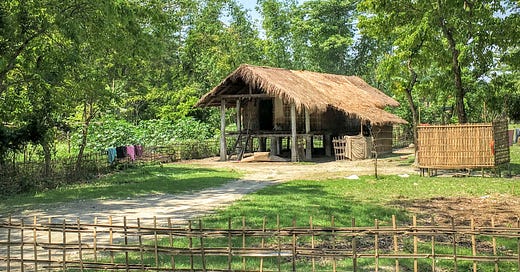Murkong Selek is a small village at Assam-Arunachal Border. It is also the last railway station on that route. I have always liked the name and its literal translation. Murkong means ‘Silver’, and Selek can be loosely translated into ‘field’ or ‘ground.’ An exact English equivalent of ‘Selek’ will probably be difficult to find. So, while I knew the name meant ‘Field of Silver’, I never seriously explored the etymology. However, this time around, I did some digging.
Writing history is complex. One of the many drawbacks of not having ‘written history’ is that many get ‘creative’ and throw out various theories. While these attempts need to be appreciated, finding an empirically proven theory amidst all the ‘clutter’ becomes difficult. Especially making sense of oral history and legends. At this moment, I am exploring places where I can learn about oral history writing. But that’s for a later discussion.
I found two fascinating narratives behind the name ‘Murkong Selek’. Both the versions are linked to the Burmese invasions of Assam. In Assam, Burmese invasions from 1819-26 are known as ‘Maanor Din.’ Historical narratives and accounts talk of this period as a phase of extreme exploitation and oppression. Under this context, the name Murkong Selek finds its origin. Both the narratives were passed down to generations as oral histories, which later found its’ way to history books.
Version 1
According to Dr Nomal Chandra Pegu (2011), as recounted in his book, “The Mishings of the Brahmaputra Valley”, it is said that gold and silver ornaments looted by the Burmese from several Assamese villages were found scattered all over the region. The local population, mainly Misings, continued to come across these silver coins and ornaments in the later years too. Therefore, the place came to be known as Murkong Selek from Murkong (silver) and Selek (field).(1)
Version-2
The second version, somewhat similar to the first, takes the shape of a local legend. This version was shared with me by Peter Pegu, the president of the Mishing Society of Mumbai. Pegu has also written extensively about the Misings. He narrates the story that he heard from his grandfather as a 12-year-old. The story goes like this (shared verbatim)
“Yakami was a Mishing girl of historical reference, particularly the Assam-Burma War (1819-1826 AD). But the present generations of the community take her as a legendary figure and has promoted her as a cult of a canonical entity. She was a captive of the Burmese soldiers, and along with many others, she was carried away to the Burmese capital to make them domestic servants. However, one opportune time, Yakami escaped and ran home back from the far-away Burmese capital. They say it took her almost one month. Her journey narratives include the crucial times of encountering wild beasts, predators, poisonous reptiles, etc. But it was said an angel in the form of ‘Sirki Nahne’ appeared in the midst of the forest to protect her from all those predators. Sirki Nahne blessed her safe journey and then promised Yakami a bountiful establishment at a place where the hills and the plains meet. Sirki Nahne briefly pronounced, “I call the country ‘Murkong-Selek’, a promised land of silver abundance.”[2] Even today, the posterity of Yakami, who was also called Mirem-Mine, or the Rich Lady of Murkong Selek, counts their genealogy down to their own.”
I lay out both the versions with equal importance and shall leave it to the readers to decide on the version they like better. Meanwhile, I shall continue to dig deeper to find out more about the etymology of Murkong Selek.
Why Murkong Selek
Recently, the Assam Chief Minister visited Dhemaji and conducted a cabinet meeting amidst all pomp and show. Among all the decisions that were taken on that day was also the Dilution of Murkong Selek Tribal Belt and Block-which is the oldest and the largest Tribal belt with a Mising majority population. Another existing tribal belt was denotified, while one additional belt was created.
Murkong Selek, to me, is representative of our struggle for land and survival. With no sixth schedule protection, tribal belts and blocks are one of the means to continue to hold on to our land. With the advent of modern capitalism and democracy, papers are needed to prove ownership of land. The majority of the Misings do not have land pattas. We are constantly evicted by floods and development projects, and our language is steadily declining.
So Murkong Selek will be a blog where I write about music, language, culture, rivers, and food of the Mising community. There shall be some political analysis too. I cannot help it. :)
Much is being written about us. The idea, through this blog, is not to gatekeep knowledge but to add to it. The attempt will be to put out accurate information about our community without glorification or stereotypification. So, if knowing about us interests you, do follow this blog.
P.S. – Some of you might have noticed that I use two spellings, ‘Mising’ and ‘Mishing’ to refer to our community here. While I prefer the former, the other writers referred to in this blog use the latter. There is an interesting debate around the nomenclature with its own history behind it. I shall write about it in the future.
(1) Pegu, Dr. Nomal Chandra – The Mishings of the Brahmaputra Valley, Second and Revised Edition, 2011, National Library, New Market, Dibrugarh, p – 56
Also, by the same author – Mishing Sakalor Itibrittwa Aru Sanskriti, 1995, Bharati Prakashan, Dibrugarh, p – 84
[2] Peter Pegu – A History of the Mishing of Eastern India, 1998, Mishing Society of Mumbai, p – 209
Also by the same author – Economic History of the Miris, 2019, Mishing Society of Mumbai, p – 132




Nice to get valuable information...
Nice write up. If I visit Morkongselek where can I stay for 1or 2 nights.